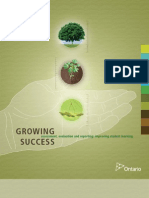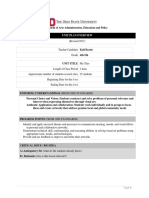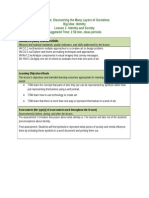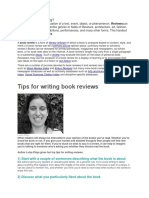Teacher Professional Growth Plan
Uploaded by
api-360865259Teacher Professional Growth Plan
Uploaded by
api-360865259Teacher Professional Growth Plan
_
PSIII Teacher Intern: Nicole Perl Semester: Fall 2019
School: F.E. Osborne School Mentor: Kevan Hunter
Professional Goal Statement #1:
Establishing and maintaining positive professional relationships with staff, students, parents, and the school community.
Rationale:
I believe that communication is at the centre of teaching and education. In order to foster a positive and successful classroom environment
professional relationships need to be established. I have chosen this as a goal for my PSIII because I want to contribute positively to the school
community and collaborate with all parties involved in order to benefit all students. This goal is something that I can continue to improve and
work on throughout my time at FEO school.
Teaching Quality Standard (Competencies):
1. Fostering Effective Relationships:
a) acting consistently with fairness, respect and integrity;
(b) demonstrating empathy and a genuine caring for others;
(c) providing culturally appropriate and meaningful opportunities for students and for parents/guardians, as partners in education, to support student
learning;
(d) inviting First Nations, Métis and Inuit parents/ guardians, Elders/knowledge keepers, cultural advisors and local community members into the
school and classroom;
(e) collaborating with community service professionals, including mental health, social services, justice, health and law enforcement; and
(f) honouring cultural diversity and promoting intercultural understanding
2. Engaging in Career-Long Learning:
(a) collaborating with other teachers to build personal and collective professional capacities and expertise;
(b) actively seeking out feedback to enhance teaching practice;
(c) building capacity to support student success in inclusive, welcoming, caring, respectful and safe learning environments;
4. Establishing Inclusive Learning Environments:
a) fostering in the school community equality and respect with regard to rights as provided for in the Alberta Human Rights Act and the
Canadian Charter of Rights and Freedoms
d) being aware of and facilitating responses to the emotional and mental health needs of students;
f) employing classroom management strategies that promote positive, engaging learning environments;
Strategy(s): Timeline(s) Resource(s) Indicator(s) of Success
Effective and consistent communication Duration of -In person Students, staff, parents,
Productive & meaningful conversations practicum conversations school community will feel
Being clear & direct with expectations -Email willing and able to
Being transparent & honest -Phone calls collaborate and communicate
Asking questions -Get-to-know with me regularly and as
you needed.
inventories
-IPPs
By the end of -In person Students, staff, parents,
Learn more about each individual student, connecting to their Sept/ Early conversations school community will feel
background & their support teams (Ed Psychologist, Parents etc.) Oct. -Meetings willing and able to
and use that information to do what is best for those students. Duration of -Email collaborate and communicate
Practicum -Phone calls with me regularly and as
Maintain professional contact with supervisors, administrators, and -Get-to-know needed.
colleagues. you
inventories
-IPPs
Reflection(s):
Professional Goal Statement #2:
Adapt and modify my lessons and assignments to differentiate for the variety of learning needs in my classroom.
Rationale:
As with most classrooms, we have a very diverse range of learning needs within each class. As of this school year, we no longer have a separate
class to support our ELL students so many of the students are in two of my sections of humanities. I am hoping to work to figure out how to make
sure I am utilizing universal design strategies and to adapt lessons as needed for our ELL students, students with IPPs, and all other learners. I am
finding many of my students struggle with reading and writing so I have chosen this goal to work towards benefitting their learning. I also aim to
find ways to enrich learning for advanced students as well.
Teaching Quality Standard (Competencies):
1. Fostering Effective Relationships:
(a) acting consistently with fairness, respect and integrity;
(b) demonstrating empathy and a genuine caring for others;
(c) providing culturally appropriate and meaningful opportunities for students and for parents/guardians, as partners in education, to support student
learning
3. Demonstrating a professional body of knowledge:
• a) incorporate a range of instructional strategies, including the appropriate use(s) of digital technology, according to the context, content, desired
outcomes and the learning needs of students; • ensure that all students continuously develop skills in literacy and numeracy; • communicate high
expectations for all students; • foster student understanding of the link between the activity and the intended learning outcomes; • consider relevant
local, provincial, national and international contexts and issues; • are varied, engaging and relevant to students; • build student capacity for
collaboration; • incorporate digital technology and resources, as appropriate, to build student capacity for: - acquiring, applying and creating new
knowledge; - communicating and collaborating with others, - critical-thinking; and - accessing, interpreting and evaluating information from diverse
sources; • consider student variables, including: - demographics, e.g. age, gender, ethnicity, religion; - social and economic factors; - maturity; -
relationships amongst students; - prior knowledge and learning; - cultural and linguistic background; - second language learning; - health and well-
being; - emotional and mental health; and - physical, social and cognitive ability;
(b) using instructional strategies to engage students in meaningful learning activities, based on:
• specialized knowledge of the subject areas they teach; • an understanding of students’ backgrounds, prior knowledge and experiences; • a
knowledge of how students develop as learners;
(c) applying student assessment and evaluation practices that:
• accurately reflect the learner outcomes within the programs of study; • generate evidence of student learning to inform teaching practice through a
balance of formative and summative assessment experiences; • provide a variety of methods through which students can demonstrate their
achievement of the learning outcomes; • provide accurate, constructive and timely feedback on student learning; and • support the use of reasoned
judgment about the evidence used to determine and report the level of student learning.
4. Establish Inclusive Learning Environments:
(a) fostering in the school community equality and respect with regard to rights as provided for in the Alberta Human Rights Act and the Canadian
Charter of Rights and Freedoms;
(b) using appropriate universal and targeted strategies and supports to address students’ strengths, learning challenges and areas for growth;
(c) communicating a philosophy of education affirming that every student can learn and be successful; (d) being aware of and facilitating responses
to the emotional and mental health needs of students;
(e) recognizing and responding to specific learning needs of individual or small groups of students and, when needed, collaborating with service
providers and other specialists to design and provide targeted and specialized supports to enable achievement of the learning outcomes;
(f) employing classroom management strategies that promote positive, engaging learning environments;
(g) incorporating students’ personal and cultural strengths into teaching and learning; and
(h) providing opportunities for student leadership.
Strategy(s): Timeline(s) Resource(s) Indicator(s) of Success
-Finding ways to boost the writing and reading skills of the students Duration of -News ELA -Students will have supports
-We read every day, I will try to find some age appropriate books that will be at Practicum site and work on skills necessary
realistic reading levels for students. -Learning for their class work.
-Friday Writing Commons
-Writing Refresh Unit -Word Work
-Peer and Self Editing
Reflection(s):
Professional Goal Statement #3:
To implement and develop more relevant FNMI lessons, resources, strategies, and knowledge into my plans and support indigenous ways of
knowing in my classroom.
Rationale:
I am aiming to find more meaningful and relevant curricular connections for my ELA units and lessons. It is extremely important for students to
learn about FNMI culture and indigenous ways of knowing and a goal I would like to achieve this practicum is to find more ways to tie this into
my lessons and daily routines.
Teaching Quality Standard (Competencies):
1. Fostering Effective Relationships
(a) acting consistently with fairness, respect and integrity;
(b) demonstrating empathy and a genuine caring for others;
(c) providing culturally appropriate and meaningful opportunities for students and for parents/guardians, as partners in education, to support student
learning;
(d) inviting First Nations, Métis and Inuit parents/ guardians, Elders/knowledge keepers, cultural advisors and local community members into the
school and classroom;
(e) collaborating with community service professionals, including mental health, social services, justice, health and law enforcement; and
(f) honouring cultural diversity and promoting intercultural understanding.
2. Engaging in Career Long Learning
(c) building capacity to support student success in inclusive, welcoming, caring, respectful and safe learning environments;
(d) seeking, critically reviewing and applying educational research to improve practice;
(e) enhancing understanding of First Nations, Métis and Inuit worldviews, cultural beliefs, languages and values; and
4.Establishing Inclusive Learning Environments
(a) fostering in the school community equality and respect with regard to rights as provided for in the Alberta Human Rights Act and the Canadian
Charter of Rights and Freedoms;
(c) communicating a philosophy of education affirming that every student can learn and be successful;
(g) incorporating students’ personal and cultural strengths into teaching and learning; and
1. Applying Foundational Knowledge about First Nations, Metis, and Inuit
(a) understanding the historical, social, economic, and political implications of: • treaties and agreements with First Nations; • legislation and
agreements negotiated with Métis; and • residential schools and their legacy;
(b) supporting student achievement by engaging in collaborative, whole school approaches to capacity building in First Nations, Métis and Inuit
education;
(c) using the programs of study to provide opportunities for all students to develop a knowledge and understanding of, and respect for, the histories,
cultures, languages, contributions, perspectives, experiences and contemporary contexts of First Nations, Métis and Inuit; and
(d) supporting the learning experiences of all students by using resources that accurately reflect and demonstrate the strength and diversity of First
Nations, Métis and Inuit.
Strategy(s): Timeline(s) Resource(s) Indicator(s) of
Success
Orange Shirt Day Sept.30th Searching for more resources… -Students will
Applying Foundational Knowledge to our lessons (Orange understand and
Utilizing indigenous ways of knowing Shirt Day) -Walking together: appreciate FNMI
Doing more research so I can find credible sources http://www.learnalberta.ca/content/aswt/ culture and ways of
Story Telling Duration of knowing
practicum http://www.orangeshirtday.org/
Circles for speaking
Indigenous People’s perspectives
Indigenous Authors
Poetry
Art
Culture infused into lessons
Reflection(s):
You might also like
- 50 Questions For Finding Your Passion Purpose in Life PDF100% (1)50 Questions For Finding Your Passion Purpose in Life PDF12 pages
- A Professional Growth Plan Incorporating The STP ProcessNo ratings yetA Professional Growth Plan Incorporating The STP Process3 pages
- Danielson Aligned Lesson Plan Template For Formal ObservationsNo ratings yetDanielson Aligned Lesson Plan Template For Formal Observations13 pages
- 10 Geography Lesson Plans for KS1 - Volume 1: Our School and the Local Area & An Island HomeFrom Everand10 Geography Lesson Plans for KS1 - Volume 1: Our School and the Local Area & An Island HomeNo ratings yet
- Republic of The Philippines College of Education Graduate School Sta. Mesa, Manila91% (11)Republic of The Philippines College of Education Graduate School Sta. Mesa, Manila38 pages
- Self-Assessment and Professional Learning Plan/resilience100% (1)Self-Assessment and Professional Learning Plan/resilience4 pages
- Multicultural Lesson Plan (100 Points) How Do You Celebrate The Holiday?No ratings yetMulticultural Lesson Plan (100 Points) How Do You Celebrate The Holiday?4 pages
- Final LTC 4240 Art Integration Lesson Plan Template-2No ratings yetFinal LTC 4240 Art Integration Lesson Plan Template-27 pages
- Art Education Lesson Plan Template Art 133-2No ratings yetArt Education Lesson Plan Template Art 133-28 pages
- What Is Our Purpose?: © International Baccalaureate Organization 2019No ratings yetWhat Is Our Purpose?: © International Baccalaureate Organization 20194 pages
- Integrating Social and Language Arts Into ArtNo ratings yetIntegrating Social and Language Arts Into Art8 pages
- Name - : Grade 8 Science Extension Menu SpaceNo ratings yetName - : Grade 8 Science Extension Menu Space2 pages
- Residential Schools Reconciliation Info Graphic ResourcesNo ratings yetResidential Schools Reconciliation Info Graphic Resources2 pages
- Lessons That Fit: English Language Learner: (A) Lesson PlanNo ratings yetLessons That Fit: English Language Learner: (A) Lesson Plan6 pages
- Description:: CTS Module Plan-Nicole PerlNo ratings yetDescription:: CTS Module Plan-Nicole Perl3 pages
- Gingerbread Lesson 1-Original Story and Visual Journal 22what Happened Next 22No ratings yetGingerbread Lesson 1-Original Story and Visual Journal 22what Happened Next 224 pages
- Lesson Plan For Grade 3 Mindfulness ActivityNo ratings yetLesson Plan For Grade 3 Mindfulness Activity1 page
- Emergency Tachyarrhythmia Management: Chaval Srisakvarakul, MD Electrophysiologist, Chulabhorn HospitalNo ratings yetEmergency Tachyarrhythmia Management: Chaval Srisakvarakul, MD Electrophysiologist, Chulabhorn Hospital77 pages
- Pap Certification of Psychology Specialists Primer PDFNo ratings yetPap Certification of Psychology Specialists Primer PDF19 pages
- Application Checklist: (Please Tick For Documents Submitted)No ratings yetApplication Checklist: (Please Tick For Documents Submitted)2 pages
- Historical Background and Development of Profession of PharmacyNo ratings yetHistorical Background and Development of Profession of Pharmacy11 pages
- Critical Essay Final Draft 1 Personal ResponseNo ratings yetCritical Essay Final Draft 1 Personal Response5 pages
- My Enemy'S Enemy Is My Friend: It Makes Sense To Assume That, All OtherNo ratings yetMy Enemy'S Enemy Is My Friend: It Makes Sense To Assume That, All Other5 pages
- Wang CSPNet A New Backbone That Can Enhance Learning Capability of CVPRW 2020 PaperNo ratings yetWang CSPNet A New Backbone That Can Enhance Learning Capability of CVPRW 2020 Paper10 pages
- Full Download of Test Bank For Child and Adolescent Development in Context, 1st Edition Tara L. Kuther in PDF DOCX Format100% (3)Full Download of Test Bank For Child and Adolescent Development in Context, 1st Edition Tara L. Kuther in PDF DOCX Format37 pages
- 50 Questions For Finding Your Passion Purpose in Life PDF50 Questions For Finding Your Passion Purpose in Life PDF
- A Professional Growth Plan Incorporating The STP ProcessA Professional Growth Plan Incorporating The STP Process
- Danielson Aligned Lesson Plan Template For Formal ObservationsDanielson Aligned Lesson Plan Template For Formal Observations
- 10 Geography Lesson Plans for KS1 - Volume 1: Our School and the Local Area & An Island HomeFrom Everand10 Geography Lesson Plans for KS1 - Volume 1: Our School and the Local Area & An Island Home
- Republic of The Philippines College of Education Graduate School Sta. Mesa, ManilaRepublic of The Philippines College of Education Graduate School Sta. Mesa, Manila
- Self-Assessment and Professional Learning Plan/resilienceSelf-Assessment and Professional Learning Plan/resilience
- Multicultural Lesson Plan (100 Points) How Do You Celebrate The Holiday?Multicultural Lesson Plan (100 Points) How Do You Celebrate The Holiday?
- Final LTC 4240 Art Integration Lesson Plan Template-2Final LTC 4240 Art Integration Lesson Plan Template-2
- What Is Our Purpose?: © International Baccalaureate Organization 2019What Is Our Purpose?: © International Baccalaureate Organization 2019
- Residential Schools Reconciliation Info Graphic ResourcesResidential Schools Reconciliation Info Graphic Resources
- Lessons That Fit: English Language Learner: (A) Lesson PlanLessons That Fit: English Language Learner: (A) Lesson Plan
- Gingerbread Lesson 1-Original Story and Visual Journal 22what Happened Next 22Gingerbread Lesson 1-Original Story and Visual Journal 22what Happened Next 22
- Emergency Tachyarrhythmia Management: Chaval Srisakvarakul, MD Electrophysiologist, Chulabhorn HospitalEmergency Tachyarrhythmia Management: Chaval Srisakvarakul, MD Electrophysiologist, Chulabhorn Hospital
- Pap Certification of Psychology Specialists Primer PDFPap Certification of Psychology Specialists Primer PDF
- Application Checklist: (Please Tick For Documents Submitted)Application Checklist: (Please Tick For Documents Submitted)
- Historical Background and Development of Profession of PharmacyHistorical Background and Development of Profession of Pharmacy
- My Enemy'S Enemy Is My Friend: It Makes Sense To Assume That, All OtherMy Enemy'S Enemy Is My Friend: It Makes Sense To Assume That, All Other
- Wang CSPNet A New Backbone That Can Enhance Learning Capability of CVPRW 2020 PaperWang CSPNet A New Backbone That Can Enhance Learning Capability of CVPRW 2020 Paper
- Full Download of Test Bank For Child and Adolescent Development in Context, 1st Edition Tara L. Kuther in PDF DOCX FormatFull Download of Test Bank For Child and Adolescent Development in Context, 1st Edition Tara L. Kuther in PDF DOCX Format

































































































